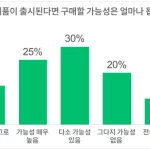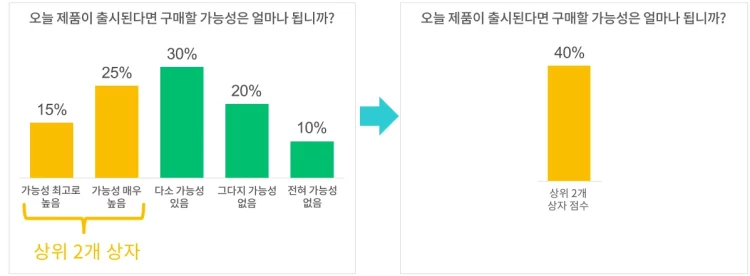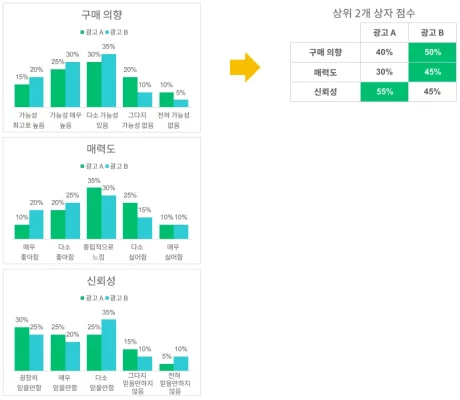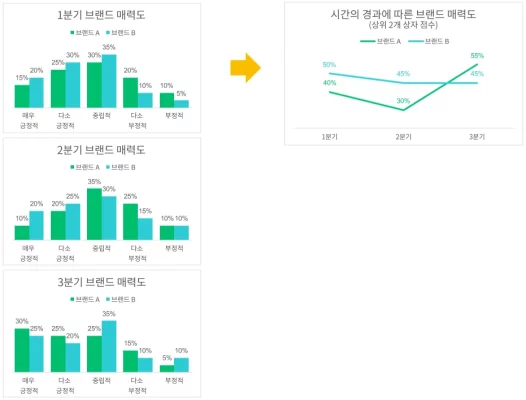설문조사 분석에서 상위 2개 상자 점수 사용 방법

잠재 고객이 귀사의 제품을 구매할 가능성은 얼마나 됩니까? 고객이 만족해 하고 있나요? 브랜드는 매력적인가요?
이러한 각 질문은 다양한 답변을 끌어내어 응답을 해석하는 일을 복잡하게 만듭니다. 응답 데이터에서 꼭 필요한 부분만 간추려 정리하려면 쉽게 요약할 수 있게 주요 값을 강조 표시하는 설문조사 분석 기법인 상위 2개 상자 점수(Top 2 Box score)를 사용해 보세요.
상위 2개 상자 점수가 설문조사 분석에 어떻게 도움이 되는지 알아보고, 다양한 관련 양식에 대해서도 자세히 안내해 드리겠습니다. 이를 통해 추후 질문을 작성하거나 설문조사 응답을 분석할 때 상위 2개 상자 점수에 대한 지식을 바탕으로 설문조사를 최대한 활용하실 수 있습니다.
먼저 상위 2개 상자 점수가 무엇인지 정확하게 알아보겠습니다.
상위 2개 상자 점수 정의하기
아래 예를 통해 상위 2개 점수 계산 과정을 좀 더 구체적으로 알아보겠습니다.
상위 2개 상자 점수 계산 방법
애완동물 사료 회사의 마케팅 담당자라고 가정해 보세요. 목표 시장 즉, 애완동물 보호자를 대상으로 두어 가지 광고 아이디어를 테스트해 보고 싶습니다. 설문조사를 통해 애완동물 보호자들이 광고를 본 후 회사 제품을 구매하거나 구매하지 않을 가능성이 얼마나 되는지 파악하고자 합니다.
답을 얻기 위해 다음과 같은 5점 척도의 구매 의향에 대한 질문을 사용할 수 있습니다.
오늘 제품이 출시된다면 구매할 가능성은 얼마나 됩니까?
- 가능성 최고로 높음
- 가능성 매우 높음
- 다소 가능성 있음
- 그다지 가능성 없음
- 가능성 전혀 없음
설문조사 응답을 수집하고 나면 다음과 같은 데이터를 얻을 수 있습니다.

마케팅 담당자라면, 광고를 본 후 제품을 구매할 가능성이 있는 사람들의 비율을 알아내는 데 가장 관심이 있을 것입니다. 이 예에서 상위 2개 상자 응답은 처음 두 가지 긍정적 응답인 가능성 최고로 높음 및 가능성 매우 높음입니다. 다음과 같이 이 두 개 응답을 합치면 상위 2개 상자 점수를 계산할 수 있습니다.
15%(가능성 최고로 높음) + 25%(가능성 매우 높음) = 40%(상위 2개 상자)

전문가 팁: SurveyMonkey 분석에서 답항을 결합하여 쉽게 상위 2개 상자 점수를 구할 수 있습니다.
상위 2개 상자 점수 계산 방법을 알았으니 이제 이 기능을 사용하는 이유에 대해 이야기해 보겠습니다.
상위 2개 박스 점수를 사용하는 이유
1) 분석을 단순화합니다. 5개 이상의 수치를 검토하는 대신 1개만 살펴보면 됩니다.
2) 비교가 빠르고 쉽습니다. 예를 들어 콘셉트를 테스트할 때 브랜드에 대한 결과를 비교하든 자극 요인에 대한 결과를 비교하든 상위 2개 상자 점수로 결과를 나란히 더욱 효율적으로 비교할 수 있습니다.
애완동물 사료 회사의 예를 다시 살펴보겠습니다. 구매 의향 질문뿐만 아니라 매력도와 신뢰성에 대한 질문도 했다고 가정해 보세요. 상위 2개 상자 점수를 사용하면 해석하기 힘든 다수의 차트에서 벗어나 깔끔하고 단순한 성과 기록표로 쉽게 분석할 수 있습니다.

3) 더 쉽게 추세를 포착할 수 있습니다. 시간의 경과에 따른 메트릭을 확인할 때 상위 2개 상자 점수가 데이터에서 추세를 파악하는 데 도움이 됩니다.
예를 들어 회사 브랜드와 경쟁사 브랜드의 매력도를 트래킹한다고 가정해 보겠습니다. 이 경우 각 브랜드의 상대적인 인식도를 측정하는 5점 척도 질문을 사용합니다. 분기마다 결과를 트래킹하면서 각 브랜드의 인식도 추세를 나란히 확인할 수 있습니다.
상위 2개 상자 점수를 사용하면 하나의 그림에서 특정 기간 동안의 분석 결과를 확인할 수 있습니다.

직감을 테스트할 준비가 되셨나요?
SurveyMonkey Audience는 전 세계에 걸쳐 의견을 제공할 소비자를 보유하고 있습니다.
상위 2개 상자 점수의 변형
상위 2개 상자 점수의 여러 가지 변형이 있습니다. 다음은 가장 일반적인 양식 중 일부입니다.
상위 상자 점수
척도에서 가장 높은 긍정적 응답에만 관심이 있다면 상위 상자 점수를 사용하세요. 예를 들어 고객 유지율 개선 방법을 모색 중이며 별 등급 질문을 사용하여 고객 만족도를 측정할 계획이라면 장기간에 걸쳐 별 5개를 주는 고객의 비율을 높이는 데 더 관심이 있을 수 있습니다.
저희 서비스를 어떻게 평가하시겠습니까?
- ★★★★★
- ★★★★
- ★★★
- ★★
- ★
상위 상자 점수를 계산하려면 맨 위 답항을 선택하는 응답자의 비율만 확인하면 됩니다. 따라서 20%의 응답자가 별 5개를 선택한다면 상위 상자 점수는 간단히 20%일 것입니다.
상위 3개 상자 점수
5점 이상의 척도를 사용하는 리커트 척도 질문에는 상위 3개 상자 점수를 사용하세요. 계산 방법은 상위 2개 상자와 비슷하여 상위 3개의 긍정적 응답을 모두 더합니다.
받으신 고객 서비스에 얼마나 만족하거나 불만족하셨습니까?
- 완전히 만족
- 매우 만족
- 만족함
- 중립적
- 불만족함
- 매우 불만족
- 완전히 불만족
하위 2개 상자 점수
리커트 척도 질문으로부터 부정적 응답을 집계하고자 한다면 상위 2개 상자 대신 하위 2개 상자를 사용할 수도 있습니다. 예를 들어, 브랜드 전환 설문조사 템플릿의 다음 브랜드 충성도 질문을 살펴보세요.
다음 구매 시 다른 브랜드로 전환할 가능성은 얼마나 됩니까?
- 가능성 최고로 높음
- 가능성 매우 높음
- 다소 가능성 있음
- 그다지 가능성 없음
- 가능성 전혀 없음
충성 고객을 정량화하는 메트릭을 만들기 위해 하위 2개 상자를 사용하세요. 하위 2개 응답(‘그다지 가능성 없음’ 및 ‘전혀 가능성 없음’)을 더하면 됩니다.
가중 상위 2개 상자 점수
상위 2개 상자를 심층 분석하고 싶은 경우가 종종 있습니다. 두 가지 서로 다른 제품 콘셉트에 대한 구매 의향 질문에서 다음과 같이 상위 2개 상자 점수를 분류해 보세요.
제품 A
상위 2개 상자 점수: 40%
구매 가능성 최고로 높음: 15%
구매 가능성 매우 높음: 25%
제품 B
상위 2개 상자 점수: 40%
구매 가능성 최고로 높음: 30%
구매 가능성 매우 높음: 15%
이 경우, 두 제품의 상위 2개 상자 점수가 똑같기 때문에 동일한 결론을 도출할 수 있습니다. 하지만 제품 B에 대한 ‘구매 가능성 최고로 높음’ 응답이 두 배이므로 제품 A보다 구매 의향이 상당히 더 높은 것입니다.

이 예를 통해 특히 비교 결과가 매우 비슷할 때 집합적인 상위 2개 상자 점수에만 항상 의존할 수 없다는 것을 알 수 있습니다. 가중 상위 2개 상자 점수(또는 단일 상위 상자 점수)를 사용하면 비교 결과를 더 명확하게 이해할 수 있으며, 광고를 다시 테스트하거나 표본 크기를 늘려 설문조사를 다시 수행하지 않아도 됩니다.
가중 상위 2개 상자 점수 계산 방법
가중 상위 2개 상자 점수는 다음과 같이 계산됩니다.
(상위 상자 점수 * 상위 상자 가중치) + (두 번째 상자 점수 * 두 번째 상자 가중치) = 가중 상위 2개 상자 점수
위의 등식에서 다소 주관적인 부분은 가중치 그 자체입니다. 상위 2개 상자 점수의 가중치 결정 시 몇 가지 통상적 원칙은 다음과 같습니다.
- 상위 상자 가중치와 두 번째 상자 가중치가 같아서는 안 됩니다.
- 두 개의 가중치를 더한 합은 1이 되어야 합니다.
- 상위 상자의 가중치는 일반적으로 두 번째 상자의 가중치보다 큽니다. 그 이유는 서열 리커트 척도 질문 유형의 상위 상자가 보통 최고로 긍정적인 답변으로 시장 성과를 더 잘 예측하기 때문입니다.
- 가중치 결정 시 제품 카테고리와 소비자 의사 결정 수준을 고려해야 합니다. 예를 들어 치약과 같이 부담 없이 쉽게 구매할 수 있는 제품이라면 설문조사에서 소비자가 더 정확한 답변을 제공할 수 있으므로 상위 상자에 더 높은 가중치를 줄 수 있습니다. 하지만 자동차 구매와 같이 더 많은 생각이 필요한 제품의 경우에는 상위 상자에 약간 더 높은 가중치만 주면 됩니다.
상위 2개 상자 점수는 모든 시장 조사 전문가에게 꼭 필요한 기능입니다. 광고 테스트 관련 결과를 수집했든, 제품 피드백 관련 결과를 수집했든, 브랜드 인지도 관련 결과를 수집했든 상위 2개 상자 점수가 설문조사 분석의 효율성을 높이고 올바른 의사 결정을 하도록 도울 것입니다.
리소스 더 살펴보기

도구 키트 디렉터리
역할 또는 업계에서 피드백을 활용할 수 있도록 돕기 위해 디자인한 도구 키트를 살펴보세요.

설문조사
전문가가 작성한 400개 이상의 맞춤형 설문조사 템플릿을 둘러보세요. SurveyMonkey로 관심을 끄는 설문조사를 신속하게 만들어 보내세요.

퇴사자 인터뷰 양식을 만들어 개선이 필요한 영역 파악
퇴사자 인터뷰 설문조사에서 올바른 질문을 하여 직원 감소율을 낮추세요. 직원 양식 작성기 도구와 템플릿으로 지금 시작하세요.

온라인 동의서 양식으로 필요한 허가를 받으세요
맞춤 동의서 양식으로 필요한 허가를 받으세요. 지금 무료로 가입하여 동의서 양식 템플릿으로 간편하게 양식을 만드세요.